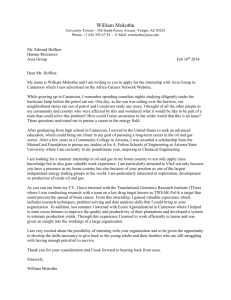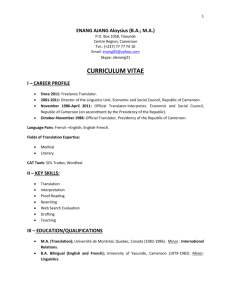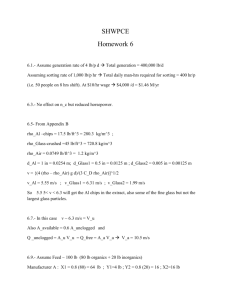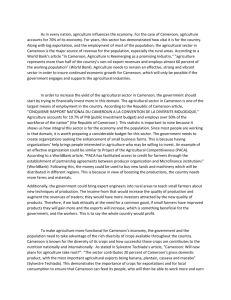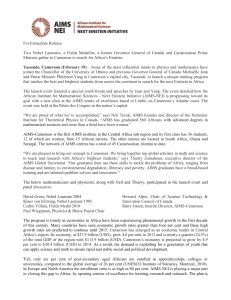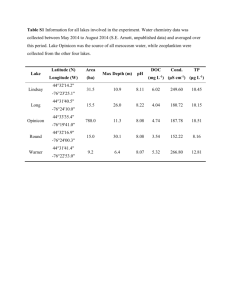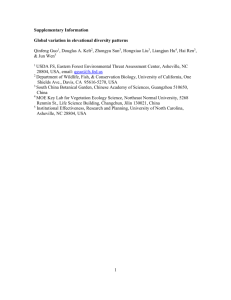Electronic supplemental material Title: Abundance
advertisement
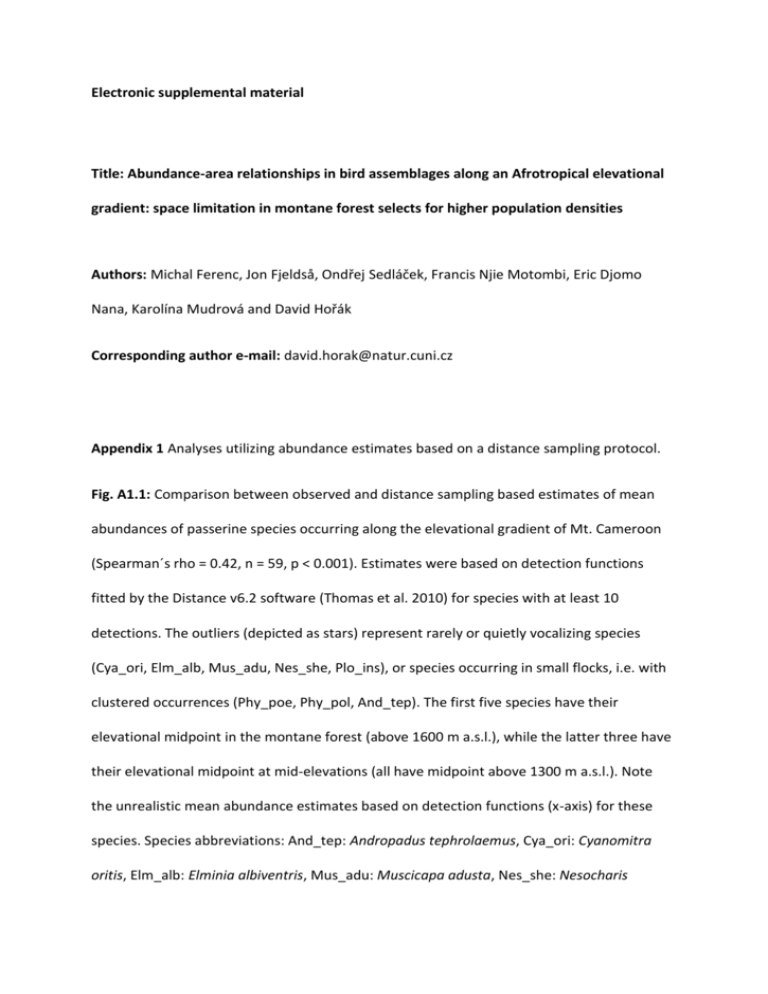
Electronic supplemental material Title: Abundance-area relationships in bird assemblages along an Afrotropical elevational gradient: space limitation in montane forest selects for higher population densities Authors: Michal Ferenc, Jon Fjeldså, Ondřej Sedláček, Francis Njie Motombi, Eric Djomo Nana, Karolína Mudrová and David Hořák Corresponding author e-mail: david.horak@natur.cuni.cz Appendix 1 Analyses utilizing abundance estimates based on a distance sampling protocol. Fig. A1.1: Comparison between observed and distance sampling based estimates of mean abundances of passerine species occurring along the elevational gradient of Mt. Cameroon (Spearman´s rho = 0.42, n = 59, p < 0.001). Estimates were based on detection functions fitted by the Distance v6.2 software (Thomas et al. 2010) for species with at least 10 detections. The outliers (depicted as stars) represent rarely or quietly vocalizing species (Cya_ori, Elm_alb, Mus_adu, Nes_she, Plo_ins), or species occurring in small flocks, i.e. with clustered occurrences (Phy_poe, Phy_pol, And_tep). The first five species have their elevational midpoint in the montane forest (above 1600 m a.s.l.), while the latter three have their elevational midpoint at mid-elevations (all have midpoint above 1300 m a.s.l.). Note the unrealistic mean abundance estimates based on detection functions (x-axis) for these species. Species abbreviations: And_tep: Andropadus tephrolaemus, Cya_ori: Cyanomitra oritis, Elm_alb: Elminia albiventris, Mus_adu: Muscicapa adusta, Nes_she: Nesocharis shelleyi, Phy_poe: Phyllastrephus poensis, Phy_pol: Phyllastrephus poliocephalus, Plo_ins: 30 oPhy_pol 20 o And_tep oPhy_poe oPlo_ins o Elm_alb 10 Observed mean abundance 40 50 Ploceus insignis. Nes_she o 0 50 Cya_ori o Mus_adu o 100 Estimated mean abundance 150 Fig. A1.2: Abundance-range size relationship of passerine species occurring along the elevational gradient of Mt. Cameroon (Spearman´s rho = -0.25, n = 108, p < 0.05). Abundance estimates are derived from a distance sampling protocol for species with at least 10 detections. Note that range sizes (x-axis) are log transformed, estimated abundances (yaxis) are square-root transformed. The depicted trend is a regression line fitted by the ordinary least squares method. Grey triangles represent endemic species or sub-species. 300 250 Estimated abundance 200 150 100 50 5 1 2 10 Range size (1°x1° cells) 3 10 Fig. A1.3: Mean abundances of passerine species across elevations (Kruskal-Wallis chisquare: 18.00, df = 2, p < 0.001) divided into three groups based on the position of the midpoint of their elevational distribution on Mt. Cameroon (see Methods). Abundance estimates are derived from a distance sampling protocol for species with at least 10 200 150 100 50 0 Estimated abundance 250 300 detections. lowland middle Midpoint position montane Appendix 2 References to primary resources used to determine the upper and lower elevational limits of occurrence of passerines on Mt. Cameroon 1. Bannermann, D.A. 1915. Report on the birds collected by the late Mr. Boyd Alexander (Rifle Brigade) during his last expedition to Africa - Part IV. The birds of Cameroon Mountain. - Ibis 57: 473-526. 2. Bayly, N. and Motombe, F. N. 2004. Final report of an ornithological survey of Mount Cameroon. - Wildlife Conservation Society. 3. Boulton, R. and Rand, A. L. 1952. A collection of birds from Mount Cameroon. Fieldiana 34: 35-64. 4. Eisentraut, M. 1973. Die Wirbeltierfauna von Fernando Poo und Westkamerun. Bonner -Zoologische Monographien, 3. 5. Serle, W. 1950. A contribution to the ornithology of the British Cameroons. - Ibis 92: 602-638. 6. Serle, W. 1964. The lower altitudinal limit of the montane forest birds of the Cameroon Mountain, Weat Africa. - Bulletin of the British Ornithologists‘ Club 84: 8791. 7. Stuart, S.N. 1986. Conservation of Cameroon montane forests. - International Council for Bird Preservation, Cambridge, UK. 8. Young, CH.G. 1946. Notes on some birds of the Cameroon Mountain district. - Ibis 88: 348-382. Appendix 3 Assemblage-level abundance-range size relationships along elevations Fig. A3: Abundance-range size relationships of individual passerine bird assemblages along the elevational gradient of Mt. Cameroon. a) 350 m a.s.l.: Spearman´s rho = 0.39, n= 53, p < 0.01; b) 650 m a.s.l.: rho = 0.26, df = 61, p < 0.05; c) 1100 m a.s.l.: rho = -0.20, df = 50, p = 0.15; d) 1500 m a.s.l.: rho = -0.40, n= 34, p < 0.05; e) 1850 m a.s.l.: rho = -0.37, n= 32, p < 0.05; f) 2200 m a.s.l.: rho = -0.14, n= 21, p = 0.54. Trends are depicted by regression lines fitted by the ordinary least squares method. Note log-scale used on x-axes and square-root transformation on yaxes. 50 45 40 35 30 a) 350 m b) 650 m c) 1100 m d) 1500 m e) 1850 m f) 2200 m 25 20 15 10 Abundance 5 1 50 45 40 35 30 25 20 15 10 5 1 1 10 2 3 10 1 10 2 Range size (1°x1° cells) 10 3 1 10 2 10 3
